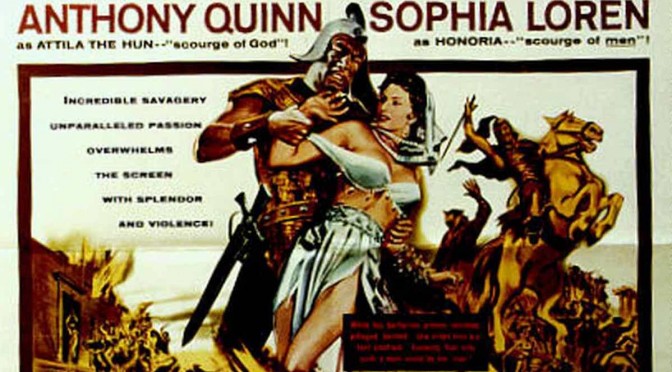Attila the Hun’s invasion of the Empire In 451 and 452 is usually considered a turning point for the Roman Empire and in a way it was but not for the reasons normally assigned to it. From the point of view of the development of the comitas as a separate class, the “nobility” it proved absolutely pivotal. The concept of defense in depth and the rapid response capability of comitatensis cavalry worked well, as did decentralised control. The new role of the Comitas was now fully defined.
Scourge of God
There can be few better introductions to the subject of Attila and the Empress Honoria than this 1954 Hollywood film. It was “historically inaccurate” as there is no record of an actual meeting between Honoria and Attila. However Honoria vanished from the Roman record immediately after Attila’s second invasion of the Empire and Attila is supposed to have died of a heart attack during strenuous sexual activity a year later. Who knows?
One version of the Geneology claimed by the Carolingian Kings of the Franks shows that Honoria did have a child, Ellak and that the Carolingians are descended from that child.
Galla Placida
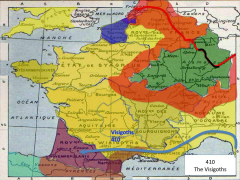 The story really starts with Honoria’s mother Galla Placida.
A measure of just how vulnerable the Empire was becoming can be judged by the fact that in the middle of making preparations to improve the security of the frontier another migration occurred. The Visigoths, already settled on the south of the Danube and acting as foederatii for the Eastern Empire decided they were being badly treated by the Emperor of the East and moved their whole population, about 60,000 people, into the Western empire. They were already inside the defensive barrier and so there was nothing to stop them. After they sacked Rome a deal was done and the agreed to become foederatii on the on the new frontier below which the Alans, Sueves and Vandals had settled. The Emperors daughter, Galla Placida left with or joined the the Goths in Septimania and four years later married Autulf, their leader.The story really starts with Honoria’s mother Galla Placida.
The story really starts with Honoria’s mother Galla Placida.
A measure of just how vulnerable the Empire was becoming can be judged by the fact that in the middle of making preparations to improve the security of the frontier another migration occurred. The Visigoths, already settled on the south of the Danube and acting as foederatii for the Eastern Empire decided they were being badly treated by the Emperor of the East and moved their whole population, about 60,000 people, into the Western empire. They were already inside the defensive barrier and so there was nothing to stop them. After they sacked Rome a deal was done and the agreed to become foederatii on the on the new frontier below which the Alans, Sueves and Vandals had settled. The Emperors daughter, Galla Placida left with or joined the the Goths in Septimania and four years later married Autulf, their leader.The story really starts with Honoria’s mother Galla Placida.
A measure of just how vulnerable the Empire was becoming can be judged by the fact that in the middle of making preparations to improve the security of the frontier another migration occurred. The Visigoths, already settled on the south of the Danube and acting as foederatii for the Eastern Empire decided they were being badly treated by the Emperor of the East and moved their whole population, about 60,000 people, into the Western empire. They were already inside the defensive barrier and so there was nothing to stop them. After they sacked Rome a deal was done and the agreed to become foederatii on the on the new frontier below which the Alans, Sueves and Vandals had settled. The Emperors daughter, Galla Placida left with or joined the the Goths in Septimania and four years later married Autulf, their leader.
She had at least one, possibly three children by Autulf.
The geneology is unreliable in the finer detail but it is certain that the Roman bloodline found it’s way into Visigothic, Burgundian and Frankish Royal Families.
Interesting Relationships
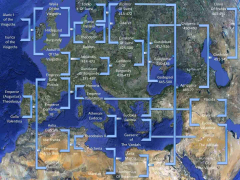 She had at least one, possibly three children by Autulf.
The geneology is unreliable in the finer detail but it is certain that the Roman bloodline found it’s way into Visigothic, Burgundian and Frankish Royal Families.
There is some evidence that Theodoric, King of the Visgoths who died fighting the Huns at the battle of the Catalunian plain was Galla Placida’s son. It is possible but if so he could only have been eight when he was hailed as King. Their is nothing in the record to suggest he was so young or that he needed a regent to act on his behalf.
These relationships are the reason that the Salic law, formulated by Clovis, barred succession though a female and why his family never mentioned Clothilde, their mother’s heritage. If they had made any claim dependent on Clothilde’s bloodline it would have opened up similar claims from both Visigoths and BurgundiansThere is some evidence that Theodoric, King of the Visgoths who died fighting the Huns at the battle of the Catalunian plain was Galla Placida’s son. It is possible but if so he could only have been eight when he was hailed as King. There is nothing in the record to suggest he was so young or that he needed a regent to act on his behalf.
She had at least one, possibly three children by Autulf.
The geneology is unreliable in the finer detail but it is certain that the Roman bloodline found it’s way into Visigothic, Burgundian and Frankish Royal Families.
There is some evidence that Theodoric, King of the Visgoths who died fighting the Huns at the battle of the Catalunian plain was Galla Placida’s son. It is possible but if so he could only have been eight when he was hailed as King. Their is nothing in the record to suggest he was so young or that he needed a regent to act on his behalf.
These relationships are the reason that the Salic law, formulated by Clovis, barred succession though a female and why his family never mentioned Clothilde, their mother’s heritage. If they had made any claim dependent on Clothilde’s bloodline it would have opened up similar claims from both Visigoths and BurgundiansThere is some evidence that Theodoric, King of the Visgoths who died fighting the Huns at the battle of the Catalunian plain was Galla Placida’s son. It is possible but if so he could only have been eight when he was hailed as King. There is nothing in the record to suggest he was so young or that he needed a regent to act on his behalf.
These relationships are the reason that the Salic law, formulated by Clovis, barred succession though a female and why his family never mentioned Clothilde, their mother’s heritage. If they had made any claim dependent on Clothilde’s bloodline it would have opened up similar claims from both Visigoths and Burgundians
On Aultulf’s death Galla Placida returned to Rome where she married again to the Emporer Constantius III. Constantius and Galla Placida’s son became Emperor Valantinian III and their daughter was Honoria. She became an empress in her own right.
Galla and Honaria
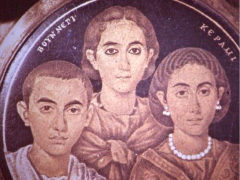 On Aultulf’s death Galla Placida returned to Rome where she married again to the Emporer Constantius III. Constantius and Galla Placida’s son became Emperor Valantinian III and their daughter was Honoria. She became an empress in her own right.
A celebrated contemorary painting shows the three of them. Surprisingly the central figure, dominating the other two, is Honoria.
Even after her return to Rome Gallida Placida was always referred to by the Visigoths as “Our Queen” and she made sure they were always treated favourably.
The flight of the female royal blood did not end there. Eudoxia Lucinia, Galla Placida’s Daughter in law and, Eudoxia Valentina, Galla Placida’s grandaughter also married outside the Empire, bringing the royal blood lines to the Vandals, who passed them on to the Visigoths in Spain and eventually back to the later East Roman (Byzantine) Emperors.A celebrated contemorary painting shows the three of them. Surprisingly the central figure, dominating the other two, is Honoria.
On Aultulf’s death Galla Placida returned to Rome where she married again to the Emporer Constantius III. Constantius and Galla Placida’s son became Emperor Valantinian III and their daughter was Honoria. She became an empress in her own right.
A celebrated contemorary painting shows the three of them. Surprisingly the central figure, dominating the other two, is Honoria.
Even after her return to Rome Gallida Placida was always referred to by the Visigoths as “Our Queen” and she made sure they were always treated favourably.
The flight of the female royal blood did not end there. Eudoxia Lucinia, Galla Placida’s Daughter in law and, Eudoxia Valentina, Galla Placida’s grandaughter also married outside the Empire, bringing the royal blood lines to the Vandals, who passed them on to the Visigoths in Spain and eventually back to the later East Roman (Byzantine) Emperors.A celebrated contemorary painting shows the three of them. Surprisingly the central figure, dominating the other two, is Honoria.
Even after her return to Rome Gallida Placida was always referred to by the Visigoths as “Our Queen” and she made sure they were always treated favourably.
The flight of the female royal blood did not end there. Eudoxia Lucinia, Galla Placida’s Daughter in law and, Eudoxia Valentina, Galla Placida’s grandaughter also married outside the Empire, bringing the royal blood lines to the Vandals, who passed them on to the Visigoths in Spain and eventually back to the later East Roman (Byzantine) Emperors.
Use of the Foederati
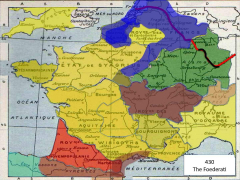 Away from the intrigues of this succession of Empresses, the implementation of the principles of defence in depth were now introduced in an economy which no longer could afford to pay for the services of the foederatii and which was desperate to increase revenue from taxation. The answer chosen was to make land grants. This was achieved by making land owners in the border areas give up one third of their land to the foedaterii. who were immediately Roman Citizens and taxpayers. The Visigoths were already along the Pyrenean frontier, Franks were allowed to expand along the North West Rhine frontier and along the boundary with the lands conquered by the Alamanii.
Saxons were introduced into the Loire valley east of Orleans and Burgundians allowed to settle in the Rhone and Saone valleys thereby constraing the southern border with the Alamanii. Finally a mixed group of Foederatii were settled on the Northern Reaches of the Alps in what is now the Tyrol.
A final piece in the jigsaw was the arrival of huge numbers of Roman Britons fleeing the Anglo Saxon invasion arriving in what is now Brittany.
Defensive measures became irretrievably mixed with issues of settlement, land tenure and fortification. It was the Dux and the Comitas who managed these complementary but conflicting issues.Away from the intrigues of this succession of Empresses, the implementation of the principles of defence in depth were now introduced in an economy which no longer could afford to pay for the services of the foederatii and which was desperate to increase revenue from taxation. The answer chosen was to make land grants. This was achieved by making land owners in the border areas give up one third of their land to the foedaterii. who were immediately Roman Citizens and taxpayers. The Visigoths were already along the Pyrenean frontier, Franks were allowed to expand along the North West Rhine frontier and along the boundary with the lands conquered by the Alamanii.
Away from the intrigues of this succession of Empresses, the implementation of the principles of defence in depth were now introduced in an economy which no longer could afford to pay for the services of the foederatii and which was desperate to increase revenue from taxation. The answer chosen was to make land grants. This was achieved by making land owners in the border areas give up one third of their land to the foedaterii. who were immediately Roman Citizens and taxpayers. The Visigoths were already along the Pyrenean frontier, Franks were allowed to expand along the North West Rhine frontier and along the boundary with the lands conquered by the Alamanii.
Saxons were introduced into the Loire valley east of Orleans and Burgundians allowed to settle in the Rhone and Saone valleys thereby constraing the southern border with the Alamanii. Finally a mixed group of Foederatii were settled on the Northern Reaches of the Alps in what is now the Tyrol.
A final piece in the jigsaw was the arrival of huge numbers of Roman Britons fleeing the Anglo Saxon invasion arriving in what is now Brittany.
Defensive measures became irretrievably mixed with issues of settlement, land tenure and fortification. It was the Dux and the Comitas who managed these complementary but conflicting issues.Away from the intrigues of this succession of Empresses, the implementation of the principles of defence in depth were now introduced in an economy which no longer could afford to pay for the services of the foederatii and which was desperate to increase revenue from taxation. The answer chosen was to make land grants. This was achieved by making land owners in the border areas give up one third of their land to the foedaterii. who were immediately Roman Citizens and taxpayers. The Visigoths were already along the Pyrenean frontier, Franks were allowed to expand along the North West Rhine frontier and along the boundary with the lands conquered by the Alamanii.
Saxons were introduced into the Loire valley east of Orleans and Burgundians allowed to settle in the Rhone and Saone valleys thereby constraining the southern border with the Alamanii. Finally a mixed group of Foederatii were settled on the Northern Reaches of the Alps in what is now the Tyrol.
A final piece in the jigsaw was the arrival of huge numbers of Roman Britons fleeing the Anglo Saxon invasion arriving in what is now Brittany.
Defensive measures became irretrievably mixed with issues of settlement, land tenure and fortification. It was the Dux and the Comitas who managed these complementary but conflicting issues.
In 439 Vandals, who had been summonsed to Northern Africa as Foederatii, but in an internal Roman dispute ( between Bonificus and Flavius Aetius triggered by each of them trying to discredit the other in the eyes of Galla Placida), declared themselves to be a Kingdom, independent of Rome. The implications of this sequence of events were disastrous for the Western Empire. without access to the grain from Egypt and Libya which were provinces of the Eastern Empire, the Western Empire was now totally dependent on grain from Africa and Mauritania (now coastal Tunisia, Algeria and Morrocco).
The Western Empire was forced to pay a full commercial price for the grain.
Not what was intended
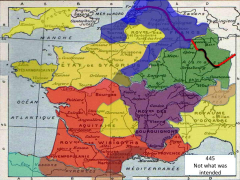 In 439 Vandals, who had been summonsed to Northern Africa as Foederatii, but in an internal Roman dispute ( between Bonificus and Flavius Aetius triggered by each of them trying to discredit the other in the eyes of Galla Placida), declared themselves to be a Kingdom, independent of Rome. The implications of this sequence of events were disastrous for the Western Empire. without access to the grain from Egypt and Libya which were provinces of the Eastern Empire, the Western Empire was now totally dependent on grain from Africa and Mauritania (now coastal Tunisia, Algeria and Morrocco).
The Western Empire was forced to pay a full commercial price for the grain.
To the North, all three of the major groups of foedaterii payed attention to this declaration and commenced a process of expansion sometimes allowed by the magister militorum, but sometimes resisted.
The Visigoths had the most success, quite probably as a result of support from Galla Placida but in any case aways making their expansion seem to be in the service of Rome, hence their move into Hispania to control The Sueves and Alans. In AD 455 on the death of Emporer Petronius Maximus it was the Visigoths who nominated his successor Avitus and avitus was not a Visigoth. Clearly up to that point they were operating at least nominally within the Roman System. Avitus was then defeated and murdered by Ricimar the Magister Militum. It was possibly from this point in time that the Visigoths made the decision to seek full independence.To the North, all three of the major groups of foedaterii payed attention to this declaration and commenced a process of expansion sometimes allowed by the magister militorum, but sometimes resisted.
In 439 Vandals, who had been summonsed to Northern Africa as Foederatii, but in an internal Roman dispute ( between Bonificus and Flavius Aetius triggered by each of them trying to discredit the other in the eyes of Galla Placida), declared themselves to be a Kingdom, independent of Rome. The implications of this sequence of events were disastrous for the Western Empire. without access to the grain from Egypt and Libya which were provinces of the Eastern Empire, the Western Empire was now totally dependent on grain from Africa and Mauritania (now coastal Tunisia, Algeria and Morrocco).
The Western Empire was forced to pay a full commercial price for the grain.
To the North, all three of the major groups of foedaterii payed attention to this declaration and commenced a process of expansion sometimes allowed by the magister militorum, but sometimes resisted.
The Visigoths had the most success, quite probably as a result of support from Galla Placida but in any case aways making their expansion seem to be in the service of Rome, hence their move into Hispania to control The Sueves and Alans. In AD 455 on the death of Emporer Petronius Maximus it was the Visigoths who nominated his successor Avitus and avitus was not a Visigoth. Clearly up to that point they were operating at least nominally within the Roman System. Avitus was then defeated and murdered by Ricimar the Magister Militum. It was possibly from this point in time that the Visigoths made the decision to seek full independence.To the North, all three of the major groups of foedaterii payed attention to this declaration and commenced a process of expansion sometimes allowed by the magister militorum, but sometimes resisted.
The Visigoths had the most success, quite probably as a result of support from Galla Placida but in any case aways making their expansion seem to be in the service of Rome, hence their move into Hispania to control The Sueves and Alans. In AD 455 on the death of Emporer Petronius Maximus it was the Visigoths who nominated his successor Avitus and Avitus was not a Visigoth. Clearly up to that point they were operating at least nominally within the Roman System. Avitus was then defeated and murdered by Ricimar the Magister Militum. It was possibly from this point in time that the Visigoths made the decision to seek full independence.
Protection Money
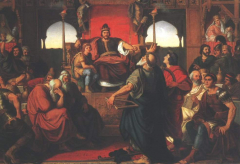 In the meantime Attila had established a principle of protection money from the Eastern Emperor. It was a simple arrangement, in return for a generous payment Attila would not cross the Danube, would nor attack Byzantium. There were frequent diplomatic exchanges between Attila and Byzantium and during one diplomatic mission Priscus, the Byzantine historian recorded in great detail the way that Attila lived. His observations are recorded in a famous painting by Mor Than which is in the Hungarian National Gallery in Budapest.In the meantime Attila had established a principle of protection money from the Eastern Emperor. It was a simple arrangement, in return for a generous payment Attila would not cross the Danube, would nor attack Byzantium. There were frequent diplomatic exchanges between Attila and Byzantium and during one diplomatic mission Priscus, the Byzantine historian recorded in great detail the way that Attila lived. His observations are recorded in a famous painting by Mor Than which is in the Hungarian National Gallery in Budapest.
In the meantime Attila had established a principle of protection money from the Eastern Emperor. It was a simple arrangement, in return for a generous payment Attila would not cross the Danube, would nor attack Byzantium. There were frequent diplomatic exchanges between Attila and Byzantium and during one diplomatic mission Priscus, the Byzantine historian recorded in great detail the way that Attila lived. His observations are recorded in a famous painting by Mor Than which is in the Hungarian National Gallery in Budapest.In the meantime Attila had established a principle of protection money from the Eastern Emperor. It was a simple arrangement, in return for a generous payment Attila would not cross the Danube, would nor attack Byzantium. There were frequent diplomatic exchanges between Attila and Byzantium and during one diplomatic mission Priscus, the Byzantine historian recorded in great detail the way that Attila lived. His observations are recorded in a famous painting by Mor Than which is in the Hungarian National Gallery in Budapest.
Invasion
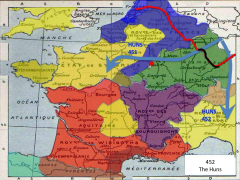 In AD 441, The Hun’s finally invaded the Empire. They poured through the Allamanii lands and swept past the defences of the Franks and the Saxons. Attila made it abundantly clear what he wanted. The hand of the Empress Justa Grata Honoria and half the empire which he judged to be hers by right.
Honoria, Empress, daughter of an Empress, possibly half brother of the Visigoth who now called himself King Theodoric, had proposed marriage to Attila in 450 and sent him her most valuable ring as proof of her scincerity. Obviously Attila was interested.
However the defence in depth worked admirably. Attila chose to ignore the fortified facilities and had reach a point half way between Orleans and Paris before he discovered that he was surrounded. He retreated rapidly but was now hampered by hit and run tactics by the Comitatenses, the Cavalry, who’s very name indicates that they were controlled by various Comes.In AD 451, The Hun’s finally invaded the Empire. They poured through the Allamanii lands and swept past the defences of the Franks and the Saxons. Attila made it abundantly clear what he wanted. The hand of the Empress Justa Grata Honoria and half the empire which he judged to be hers by right.
In AD 441, The Hun’s finally invaded the Empire. They poured through the Allamanii lands and swept past the defences of the Franks and the Saxons. Attila made it abundantly clear what he wanted. The hand of the Empress Justa Grata Honoria and half the empire which he judged to be hers by right.
Honoria, Empress, daughter of an Empress, possibly half brother of the Visigoth who now called himself King Theodoric, had proposed marriage to Attila in 450 and sent him her most valuable ring as proof of her scincerity. Obviously Attila was interested.
However the defence in depth worked admirably. Attila chose to ignore the fortified facilities and had reach a point half way between Orleans and Paris before he discovered that he was surrounded. He retreated rapidly but was now hampered by hit and run tactics by the Comitatenses, the Cavalry, who’s very name indicates that they were controlled by various Comes.In AD 451, The Hun’s finally invaded the Empire. They poured through the Allamanii lands and swept past the defences of the Franks and the Saxons. Attila made it abundantly clear what he wanted. The hand of the Empress Justa Grata Honoria and half the empire which he judged to be hers by right.
Honoria, Empress, daughter of an Empress, possibly half brother of the Visigoth who now called himself King Theodoric, had proposed marriage to Attila in 450 and sent him her most valuable ring as proof of her scincerity. Obviously Attila was interested.
However the defence in depth worked admirably. Attila chose to ignore the fortified facilities and had reach a point half way between Orleans and Paris before he discovered that he was surrounded. He retreated rapidly but was now hampered by hit and run tactics by the Comitatenses, the Cavalry, who’s very name indicates that they were controlled by various Comes.
Catalunian Plain
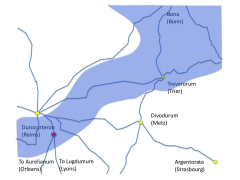 Suffering continual losses Attila made a stand at the Catalunian Plain. The site of the battle was no accident of fate. Reims was one of the great intersections of Roman roads and South east of Reims is the point where the great Roman highway from Narbonne through Nemausus and Lugdunum joined the northern road network.
This permitted the Visigoths, travelling quickly along well made roads, to take part in the battle.
Using the network of roads the Comitiatenses poured into the area, supported by all the local Limitanes who could get there in time. It was on the outer edge of the Limitanes manned by the Franks. Another ten miles and Attila would have been safe.
It was a triumph for the defensive strategy which had been devised. Historians call it a tactical defeat for Attila. The evidence suggests a resounding victory for the Romans. Most of the records of the battle have come to us through Frankish sources or sources under Frankish control. They would have wanted to describe the total collapse of the Roman Empire and the incompetance of its administration to justify their own grab for power. It just was not true The Huns were surrounded by Comitiatenses who used their archers to annihilate the huns with wave after wave of arrows. Then the cavalry moved in for the kill, heavy cavalry first to break resistance and then the light cavalry to mop up survivors. Attila was lucky he survived, most of his best troops did not.
Just for good measure Attila tried again the following year this time making a more easterly approach through Pannonia and striking direct for Rome. Again the defensive system worked, again Attila found himself surrounded. This time he retired much more quickly and there was no definitive battle. He never tried again and died shortly afterwards.
The Comitiatenses and the Comes who controlled them gained much confidence and the battle tactics used were still in use in the hundred years war nearly one thousand years later.Suffering continual losses Attila made a stand at the Catalunian Plain. The site of the battle was no accident of fate. Reims was one of the great intersections of Roman roads and South east of Reims is the point where the great Roman highway from Narbonne through Nemausus and Lugdunum joined the northern road network.
Suffering continual losses Attila made a stand at the Catalunian Plain. The site of the battle was no accident of fate. Reims was one of the great intersections of Roman roads and South east of Reims is the point where the great Roman highway from Narbonne through Nemausus and Lugdunum joined the northern road network.
This permitted the Visigoths, travelling quickly along well made roads, to take part in the battle.
Using the network of roads the Comitiatenses poured into the area, supported by all the local Limitanes who could get there in time. It was on the outer edge of the Limitanes manned by the Franks. Another ten miles and Attila would have been safe.
It was a triumph for the defensive strategy which had been devised. Historians call it a tactical defeat for Attila. The evidence suggests a resounding victory for the Romans. Most of the records of the battle have come to us through Frankish sources or sources under Frankish control. They would have wanted to describe the total collapse of the Roman Empire and the incompetance of its administration to justify their own grab for power. It just was not true The Huns were surrounded by Comitiatenses who used their archers to annihilate the huns with wave after wave of arrows. Then the cavalry moved in for the kill, heavy cavalry first to break resistance and then the light cavalry to mop up survivors. Attila was lucky he survived, most of his best troops did not.
Just for good measure Attila tried again the following year this time making a more easterly approach through Pannonia and striking direct for Rome. Again the defensive system worked, again Attila found himself surrounded. This time he retired much more quickly and there was no definitive battle. He never tried again and died shortly afterwards.
The Comitiatenses and the Comes who controlled them gained much confidence and the battle tactics used were still in use in the hundred years war nearly one thousand years later.Suffering continual losses Attila made a stand at the Catalunian Plain. The site of the battle was no accident of fate. Reims was one of the great intersections of Roman roads and South east of Reims is the point where the great Roman highway from Narbonne through Nemausus and Lugdunum joined the northern road network.
This permitted the Visigoths, travelling quickly along well made roads, to take part in the battle.
Using the network of roads the Comitiatenses poured into the area, supported by all the local Limitanes who could get there in time. It was on the outer edge of the Limitanes manned by the Franks. Another ten miles and Attila would have been safe.
It was a triumph for the defensive strategy which had been devised. Historians call it a tactical defeat for Attila. The evidence suggests a resounding victory for the Romans. Most of the records of the battle have come to us through Frankish sources or sources under Frankish control. They would have wanted to describe the total collapse of the Roman Empire and the incompetance of its administration to justify their own grab for power. It just was not true The Huns were surrounded by Comitiatenses who used their archers to annihilate the huns with wave after wave of arrows. Then the cavalry moved in for the kill, heavy cavalry first to break resistance and then the light cavalry to mop up survivors. Attila was lucky he survived, most of his best troops did not.
Just for good measure Attila tried again the following year this time making a more easterly approach through Pannonia and striking direct for Rome. Again the defensive system worked, again Attila found himself surrounded. This time he retired much more quickly and there was no definitive battle. He never tried again and died shortly afterwards.
Power to the Comes
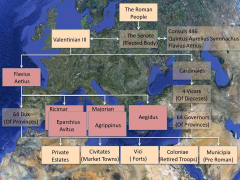 The Roman records are sufficiently complete that it is possible to identify who were the key players in this defensive effort. In the year 446. Flavius Aetius was Magister Militorum.
In the years before the Hunnic invasion he had used Huns not as Foederadatii but as mercenaries to help control the Franks and as his own personal bodyguard.
Richimar was the senior Comes. He was of Sueve/Visigothic parentage but a second cousin to Emporer Valantinian III and the Empress Honoraria.
Aegidus was possibly of Frankish extraction. He was elected King of the Franks when Childeric was accused of rape and remained so for eight years whilst Childeric was in exile outside the empire ( in Thuringia). However he was thrust to one side when Childeric returned.
Comes Majorian and Avitus both went on to become Emperors.
Comitas Majorian and Avitus both went on to become Emperors.The Comitiatenses and the Comes some of whom were by now Franks,Visigoths,Saxons and Sueves who controlled them gained much confidence and the battle tactics used were still in use in the hundred years war nearly one thousand years later.
The Roman records are sufficiently complete that it is possible to identify who were the key players in this defensive effort. In the year 446. Flavius Aetius was Magister Militorum.
In the years before the Hunnic invasion he had used Huns not as Foederadatii but as mercenaries to help control the Franks and as his own personal bodyguard.
Richimar was the senior Comes. He was of Sueve/Visigothic parentage but a second cousin to Emporer Valantinian III and the Empress Honoraria.
Aegidus was possibly of Frankish extraction. He was elected King of the Franks when Childeric was accused of rape and remained so for eight years whilst Childeric was in exile outside the empire ( in Thuringia). However he was thrust to one side when Childeric returned.
Comes Majorian and Avitus both went on to become Emperors.
Comitas Majorian and Avitus both went on to become Emperors.The Comitiatenses and the Comes some of whom were by now Franks,Visigoths,Saxons and Sueves who controlled them gained much confidence and the battle tactics used were still in use in the hundred years war nearly one thousand years later.
The Roman records are sufficiently complete that it is possible to identify who were the key players in this defensive effort. In the year 446. Flavius Aetius was Magister Militorum.
Aegidus
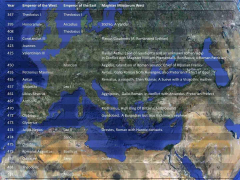 Considering the reputation this period has for instability it is rather surprising to find that Honorius ruled for twenty-six years and Valentinian III for twenty five.
This period ended with the murder of Flavius Aetus and a short time later the murder of Valeninian. Valentinian is credited with murdering Aetus and his own death was supposed to be a reprisal. It is difficult to believe that the murders were totally separate from Valantinians’s sister Honoria’s proposal to Attila and the fact that Aetus had an enduring alliance with the Huns. Certainly Flavius Aetus’ death co-incided with Honoria vanishing from the record.
After the deaths, Petronius Maximus, assumed the purple but lasted only seventy days. One of the causes of Maximus’ downfall was the second capture and sacking of Rome, this time by the Vandals. Valentinians’ wife Eudoxia Lucinia asked Gerseius, King of the Vandals to rescue herself and her daughters from the clutches of Maximus and his son. Subsequently she married Gerseric and her daughter, Eudoxia Valentina married Hunneric, Gerseric’s son from a previous union.
Whilst all this was happening Avitus was declared Emperor by the Visigoths. He returned the complement by appointing Riccimar, who was half Visigoth, to the post of Magister Militorum Praesentalis.
It took less than a year for Ricimar to take advantage of his new position to drive Avitus from office.
There then followed seventeen years in which Ricimar decided who should be Emperor including two years in which he exerted direct personal rule without the formality of declaring himself, or anyone else, Emperor. It was in this period that his one time colleague Aegidus placed himself safely behind the barrier presented by the Allamandii, Burgundians and Visigoths to set up an alternative Roman State. Aegidus died in 464 and the area he controlled was taken over by his son Sygonius.In the years before the Hunnic invasion he had used Huns not as Foederadatii but as mercenaries to help control the Franks and as his own personal bodyguard.
Considering the reputation this period has for instability it is rather surprising to find that Honorius ruled for twenty-six years and Valentinian III for twenty five.
This period ended with the murder of Flavius Aetus and a short time later the murder of Valeninian. Valentinian is credited with murdering Aetus and his own death was supposed to be a reprisal. It is difficult to believe that the murders were totally separate from Valantinians’s sister Honoria’s proposal to Attila and the fact that Aetus had an enduring alliance with the Huns. Certainly Flavius Aetus’ death co-incided with Honoria vanishing from the record.
After the deaths, Petronius Maximus, assumed the purple but lasted only seventy days. One of the causes of Maximus’ downfall was the second capture and sacking of Rome, this time by the Vandals. Valentinians’ wife Eudoxia Lucinia asked Gerseius, King of the Vandals to rescue herself and her daughters from the clutches of Maximus and his son. Subsequently she married Gerseric and her daughter, Eudoxia Valentina married Hunneric, Gerseric’s son from a previous union.
Whilst all this was happening Avitus was declared Emperor by the Visigoths. He returned the complement by appointing Riccimar, who was half Visigoth, to the post of Magister Militorum Praesentalis.
It took less than a year for Ricimar to take advantage of his new position to drive Avitus from office.
There then followed seventeen years in which Ricimar decided who should be Emperor including two years in which he exerted direct personal rule without the formality of declaring himself, or anyone else, Emperor. It was in this period that his one time colleague Aegidus placed himself safely behind the barrier presented by the Allamandii, Burgundians and Visigoths to set up an alternative Roman State. Aegidus died in 464 and the area he controlled was taken over by his son Sygonius.In the years before the Hunnic invasion he had used Huns not as Foederadatii but as mercenaries to help control the Franks and as his own personal bodyguard.
Richimar was the senior Comes. He was of Sueve/Visigothic parentage but probably a second cousin to Emporer Valantinian III and the Empress Honoraria.
Aegidus was possibly of Frankish extraction. He was elected King of the Franks when Childeric was accused of rape and remained so for eight years whilst Childeric was in exile outside the empire ( in Thuringia). However he was thrust to one side when Childeric returned.
Comes Majorian and Avitus both went on to become Emperors.
Considering the reputation this period has for instability it is rather surprising to find that Honorius ruled for twenty-six years and Valentinian III for twenty five.
This period ended with the murder of Flavius Aetus and a short time later the murder of Valeninian. Valentinian is credited with murdering Aetus and his own death was supposed to be a reprisal. It is difficult to believe that the murders were totally separate from Valantinians’s sister Honoria’s proposal to Attila and the fact that Aetus had an enduring alliance with the Huns. Certainly Flavius Aetus’ death co-incided with Honoria vanishing from the record.
After the deaths, Petronius Maximus, assumed the purple but lasted only seventy days. One of the causes of Maximus’ downfall was the second capture and sacking of Rome, this time by the Vandals. Valentinians’ wife Eudoxia Lucinia asked Gerseius, King of the Vandals to rescue herself and her daughters from the clutches of Maximus and his son. Subsequently she married Gerseric and her daughter, Eudoxia Valentina married Hunneric, Gerseric’s son from a previous union.
Whilst all this was happening Avitus was declared Emperor by the Visigoths. He returned the complement by appointing Riccimar, who was half Visigoth, to the post of Magister Militorum Praesentalis.
It took less than a year for Ricimar to take advantage of his new position to drive Avitus from office.
There then followed seventeen years in which Ricimar decided who should be Emperor including two years in which he exerted direct personal rule without the formality of declaring himself, or anyone else, Emperor. It was in this period that his one time colleague Aegidus placed himself safely behind the barrier presented by the Allamandii, Burgundians and Visigoths to set up an alternative Roman State. Aegidus died in 464 and the area he controlled was taken over by his son Sygonius.
